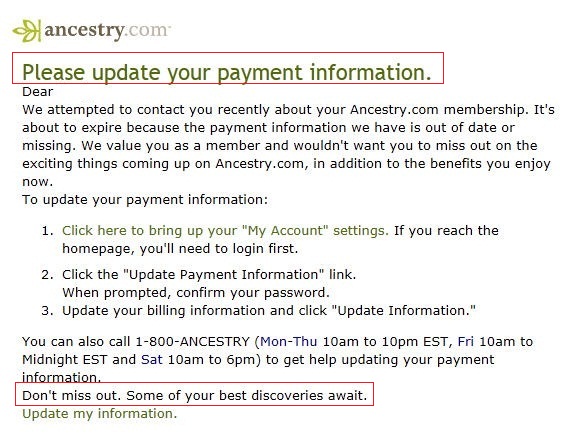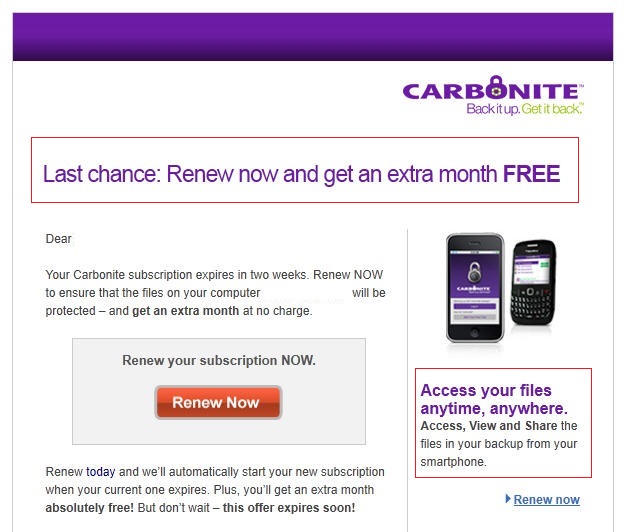The beauty of a subscription business model lies in the way it turns a single payment into many payments. Subscription renewals expand revenue streams and signify brand loyalty. But as customers approach renewal dates, software vendors should view this time as an opportunity to reaffirm the value of their product or service.
Which leads us to the dunning process. Let’s begin with definitions: The dunning process consists of identifying subscriptions that have already expired or are on the verge of expiring and sending the owner of the expiring account a notification with the goal of collecting payment.
This post focuses on the second step, sending a dunning notification, and how to do it properly in the digital age. Simply put, whether you are dealing with an online service, a SaaS product or traditional on-premise software, if you want customers to renew their subscriptions, you better inform them of what they’re missing if they don’t renew.
Benefits of Renewing
Ancestry.com is a cloud-based service that allows its subscribers to access its proprietary Web-based services to search through the company’s eight billion historical records.
Users who have spent many hours online building their family trees, or are just in the beginning stages of doing so, will be reluctant to lose access to all this data that Ancestry is hosting and keeping.
So one month prior to renewal, Ancestry begins the dunning process by identifying which accounts must be notified and sending a relatively lengthy email highlighting the value the service provides.
The lesson here is that Ancestry doesn’t settle with simply telling the customer, “Pay up.” They introduce that notification with an explanation of the benefits they provide alongside a hint at the upcoming renewal.

Only later in this email is the issue of payment fully addressed.

When handling an account with an expired card on file, the dunning process requires a company to inform the account holder of this situation. About two weeks after Ancestry attempted to charge an expired account, they sent the following email which is a little more direct in its message.

Notice how this time, after the renewal date has come and gone, the dunning notification primarily focuses its message on persuading the customer to update their payment information. At this late date, two dunning emails regarding the wonderful services Ancestry provides have already been sent. While the information about the value Ancestry’s service provides is still present in this third notification, it is clearly not the primary focus.
Consequences of Not Renewing
Carbonite is a hybrid of SaaS and traditional on-premise licenses. Users must download a software program onto their machines, but on the other hand, users are also sending their data to a cloud hosted service. In the Carbonite dunning process, a single email is sent two weeks prior to renewal with the following message:

It’s interesting to note that Carbonite uses a discount to entice subscribers to get off the fence and renew their payment. Due to the downloaded component of Carbonite’s service, it has an advantage over Ancestry in the dunning process, namely in its ability to dun customers through pop-ups on their desktop, laptop, or even mobile device as the case may be.


As you can tell, there is a sense of urgency with this dunning notification. Because the subscription is overdue, Carbonite wants to warn you of the value you may be missing by focusing on the consequences of not renewing.
The topic of managing customer loyalty is broad. With subscription models questions like “Will the customer renew?” will be your first big concern. If the customer does not renew the question becomes, “Why didn’t they?”
In digital ecommerce the dunning process should include elements of teaching the value of your service or product. Instead of simply playing debt collector, play the part of teacher. Focus your dunning process on providing customers with an explanation of the benefits they’re missing by losing the service.
Keystone
For your subscription business model, recapture expired or expiring customers by speaking to the benefits of your software.
What do you think is the proper amount of dunning notifications to send and when should they be sent? How should the message be framed? Let us know in the comments about your experiences in dunning your subscribers.
Sometimes email notifications aren’t enough – especially when emails can easily be trapped by spam filters. When we turn off a customer’s account for non-payment, I want to be EXTREMELY sure that we’ve taken every measure possible to secure their continued business. This includes a couple of phone calls if emails aren’t being responded to.
Here’s my theory – we sell business-critical software-as-a-service. If the account is disabled, then the software will either simply discontinuing doing what it’s supposed to do, or (in limited cases) will present an error message to the end customer. That’s not our goal, so we want to give our customers, the site owners, every opportunity to bring their account up-to-date.
Only after a couple of months of non-response to both emails and phone calls will I completely disable a customer’s account from our end.
Susan, I’m curious about how you handle renewal date reminders. How far in advance of a renewal do you suggest reminding customers and what kind of information do you include in these reminders? How would you advise other software companies that utilize a subscription business model on this point?
P.S. I love the idea of phone calls as part of the dunning process. In my mind, anything that personalizes the customer/vendor relationship is valuable and helps reduce customer attrition.
Most of our customers are charged monthly, so we start contacting them as soon as the card fails – or in the case of a pending expired credit card, we start emails 2 months in advance. Thanks for the P.S. – hopefully that means we’re doing something right 🙂 In general customers seem to appreciate that we’re keeping their account active and not causing them problems, as opposed to feeling like we’re invading their time or privacy.